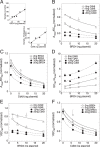Kinetically Defined Mechanisms and Positions of Action of Two New Modulators of Glucocorticoid Receptor-regulated Gene Induction
- PMID: 26504077
- PMCID: PMC4697169
- DOI: 10.1074/jbc.M115.683722
Kinetically Defined Mechanisms and Positions of Action of Two New Modulators of Glucocorticoid Receptor-regulated Gene Induction
Abstract
Most of the steps in, and many of the factors contributing to, glucocorticoid receptor (GR)-regulated gene induction are currently unknown. A competition assay, based on a validated chemical kinetic model of steroid hormone action, is now used to identify two new factors (BRD4 and negative elongation factor (NELF)-E) and to define their sites and mechanisms of action. BRD4 is a kinase involved in numerous initial steps of gene induction. Consistent with its complicated biochemistry, BRD4 is shown to alter both the maximal activity (Amax) and the steroid concentration required for half-maximal induction (EC50) of GR-mediated gene expression by acting at a minimum of three different kinetically defined steps. The action at two of these steps is dependent on BRD4 concentration, whereas the third step requires the association of BRD4 with P-TEFb. BRD4 is also found to bind to NELF-E, a component of the NELF complex. Unexpectedly, NELF-E modifies GR induction in a manner that is independent of the NELF complex. Several of the kinetically defined steps of BRD4 in this study are proposed to be related to its known biochemical actions. However, novel actions of BRD4 and of NELF-E in GR-controlled gene induction have been uncovered. The model-based competition assay is also unique in being able to order, for the first time, the sites of action of the various reaction components: GR < Cdk9 < BRD4 ≤ induced gene < NELF-E. This ability to order factor actions will assist efforts to reduce the side effects of steroid treatments.
Keywords: EC50; accelerator; cyclin-dependent kinase (CDK); decelerator; gene expression; glucocorticoid receptor; kinetically defined activity; steroid hormone; transactivation competition assay; transcription factor.
© 2016 by The American Society for Biochemistry and Molecular Biology, Inc.
Figures









References
-
- Jensen E. V., and DeSombre E. R. (1972) Mechanism of action of the female sex hormones. Annu. Rev. Biochem. 41, 203–230 - PubMed
-
- Glass C. K., and Rosenfeld M. G. (2000) The coregulator exchange in transcription functions of nuclear receptors. Genes Dev. 14, 121–141 - PubMed
-
- McKenna N. J., and O'Malley B. W. (2002) Combinatorial control of gene expression by nuclear receptors and coregulators. Cell 108, 465–474 - PubMed
-
- Simons S. S., Jr. (2003) The importance of being varied in steroid receptor transactivation. Trends Pharmacol. Sci. 24, 253–259 - PubMed
Publication types
MeSH terms
Substances
Grants and funding
LinkOut - more resources
Full Text Sources
Miscellaneous

